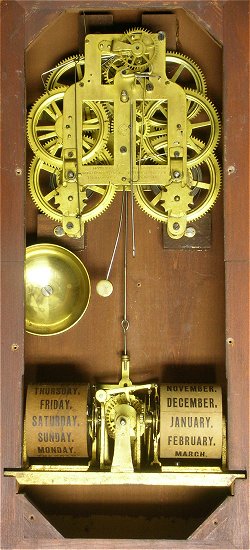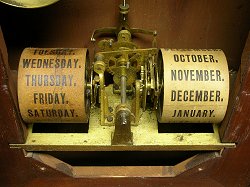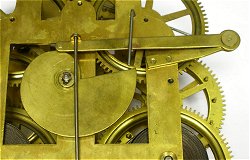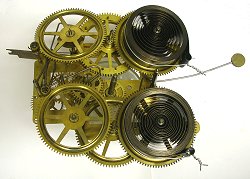Southern Calendar Clock
This Southern Calendar clock is from the 1890s. Its calendar is similar to that of the Ithaca Calendar clock of New York. The calendar mechanisms may look somewhat different, but their action is the same. While many of the Ithaca Calendar clocks have Welch movements in them, most Southern Calendar clocks have Seth Thomas movements, like the one below. There is some history at the bottom of this page.
 |
The calendar usually works well, as long as it has not been modified during any previous repairs. This calendar only required a very small adjustment to function correctly.
 |
Here is a view from the back. I just turned the mechanism around for this photo. As the label below it says, no part of the calendar mechanism should ever be lubricated.
 |
On the movement it says clearly that this clock was manufactured by the Seth Thomas Clock Co. in Thomaston, CT. for the Southern Calendar Clock Co. in St. Louis, MO.
 |
The Seth Thomas clock movement is held together with blue screws, not tapered pins, unlike earlier clocks. I would date this clock around 1900, so this would be one of the last clocks made for the Southern Calendar Clock Co.
 |
Looking at the back of the mechanism, you can see the wire, used to trip the calendar once a day.
 |
The snail allows the lever to fall. This lever and the wire hold the trip mechanism in the calendar, the weight of which moves the calendar forwards when it falls from a specified height, which is adjustable.
 |
Servicing the movement is similar to other Seth Thomas clocks, such as the ST #89. The strike count lever should have a return spring, but the clearance between the count lever and the warning lever is very tight. A return spring reduces the likelihood that the detent on the count lever would jump up unexpectly, allowing the clock to strike further.
 |
HISTORY:
The Ithaca Clock Co. was in business between 1866 and 1917 in Ithaca, New York. According to the Ithaca Daily Journal, Sept. 20th, 1875, the patents on the calendar and improvements were sold to the Seth Thomas Clock Co. This detail may help explain how the
Culver brothers got the design and used Seth Thomas movements in their calendar clocks.
The Southern Calendar Clock Company was in business from 1875 to 1899 in St. Louis, Missouri. The three Culver Brothers incorporated the business on March 2nd 1875 and manufactured these double-dial calendar clocks in their factory on 802 Washington Avenue in St. Louis. Most of the mechanisms used in their clocks were made by the Seth Thomas Clock Company in Connecticut although some have been found with movements made by the Gilbert Clock Company in Winsted, Connecticut and others by the New Haven Clock Company. They feature a "perpetual" calendar, meaning that the date hand changes from day to day adjusting automatically for 30 and 31 day months as well as for Leap Year. The company sold their clocks directly to its customers and even offered a time payment plan that allowed six months for completion (with 10% interest added). In September 1899, the Culver Brothers turned their manufacturing interest to stoves and the clockmaking business was closed.
OTHER INFORMATION:
The Southern Clock Co. is one of a number of companies located in the Southern US probably in the late 1880's. They purchased movements from New England companies (in this case Gilbert) and put them in cases, applied their label and sold them throughout the South. Clocks with New England or "Yankee" labels would not sell very well during the period following the Civil War. In addition, counties and local governments levied a tax on clocks bearing New England labels. This was in the form of a license to sell that had to be purchased for the particular county that you wanted to sell your clocks in.
THE CULVER FAMILY:
Henry Harrison Culver, the youngest child of John Milton Culver and Lydia E. Howard, was born near London, Madison County, Ohio, August 9, 1840. His father, John Milton Culver, was of Scottish descent and a native of Ohio. John was a farmer and later became a railroad contractor.
Henry Culver joined his two brothers, Lucius L. and Wallace W., in business, and from Shawneetown, Illinois, as their base, they engaged extensively in the business of selling directly to the farmers at their homes a line of cast-iron stoves, which they purchased from Ball & Co., of Cincinnati.
In 1869, they shipped all their property to Kansas City, Missouri, then in the beginning of a great boom, and disposing of their stock, they invested their total working capital of about $100,000, and opened a general house-furnishing store.
In 1873, they returned to Kansas City, where Henry owned a farm, and began as they had done in their early days in Ohio,
Finding a field for a new line of business, they organized with headquarters in St. Louis, in. 1875, "The Southern Calendar Clock Company."
Their past experience had demonstrated to them the disadvantage of trying to sell the old style cast-iron stoves. So in 1881 they organized a company for the manufacture of a family range, to be built of wrought, not of cast iron; the first of its kind ever made, and named the new organization the "Wrought Iron Range Company."
(Culver Family History)
Gearing: Introduction
Clock Repair Main Page
Escapements in Motion
Links Page
Tributes Page